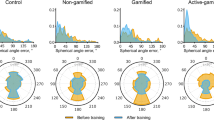Abstract
In this work we present enhanced hearing instruments (HIs) that provide vibrotactile feedback behind the user’s ears in parallel to sound. Using an additional feedback modality we display dedicated vibrotactile patterns to support the user in localizing sound sources. In a study with 4 HI users and 5 normal hearing participants we deploy the system in a gaming scenario. The open source availability of the mainstream 3D first person shooter game used in the study allowed us to add code for accessibility. We evaluate the system qualitatively with user questionnaires and quantitatively with performance metrics calculated from statistics within the game. The system was perceived as beneficial and allowed the HI users to achieve gaming performance closer to that of normal hearing participants.
Access this chapter
Tax calculation will be finalised at checkout
Purchases are for personal use only
Preview
Unable to display preview. Download preview PDF.
Similar content being viewed by others
References
prboom, http://prboom.sourceforge.net/
Ahmaniemi, T., Lantz, V.: Augmented reality target finding based on tactile cues. In: Proceedings of the 2009 International Conference on Multimodal Interfaces, pp. 335–342. ACM (2009)
Archambault, D.: Entertainment Software Accessibility: Introduction to the Special Thematic Session. In: Miesenberger, K., Klaus, J., Zagler, W., Karshmer, A. (eds.) ICCHP 2010. LNCS, vol. 6179, pp. 224–226. Springer, Heidelberg (2010)
Borg, E., Ronnberg, J., Neovius, L., Lie, T.: Vibratory-coded directional analysis: Evaluation of a three-microphone/four-vibrator DSP system. J. of Rehabilitation Research and Development 38(2) (2001)
Consortium, W.: Html5 vibration api, http://www.w3.org/TR/vibration/
Kimball, R.B.: Doom closed captioning, http://blog.rbkdesign.com/
Kochkin, S.: MarkeTrak VIII: 25-year trends in the hearing health market. Hearing Review 16(11), 12–31 (2009)
Mohebbi, R., Gray, R., Tan, H.: Driver reaction time to tactile and auditory rear-end collision warnings while talking on a cell phone. Human Factors: The Journal of the Human Factors and Ergonomics Society 51(1), 102–110 (2009)
Mueller, M., Kegel, A., Schimmel, S., Hofbauer, M., Dillier, N.: Localization of virtual sound sources with bilateral hearing aids in realistic acoustical scenes. In: PACS (2011)
Myles, K.: Guidelines for Head Tactile Communication. Tech. rep., Army Research Lab Aberdeen Proving Ground Md Human Research And Engineering Directorate (2010)
Pielot, M., Poppinga, B., Boll, S.: PocketNavigator: vibro-tactile waypoint navigation for everyday mobile devices. In: Conference on Human Computer Interaction with Mobile Devices and Services (2010)
Tessendorf, B., Derleth, P., Feilner, M., Grämer, T., Roggen, D., Spuhler, M., Stiefmeier, T., Tröster, G.: Bilateral vibrotactile feedback patterns for accurate lateralization in hearing instrument body area networks. In: 6th International Conference on Body Area Networks, Bodynets (2011)
Weisenberger, J., Heidbreder, A., Miller, J.: Development and preliminary evaluation of an earmold sound-to-tactile aid for the hearing-impaired. J. Rehabil. Res. Dev. 24, 51–66 (1987)
Author information
Authors and Affiliations
Editor information
Editors and Affiliations
Rights and permissions
Copyright information
© 2012 Springer-Verlag Berlin Heidelberg
About this paper
Cite this paper
Tessendorf, B., Derleth, P., Feilner, M., Roggen, D., Stiefmeier, T., Tröster, G. (2012). Improving Game Accessibility with Vibrotactile-Enhanced Hearing Instruments. In: Miesenberger, K., Karshmer, A., Penaz, P., Zagler, W. (eds) Computers Helping People with Special Needs. ICCHP 2012. Lecture Notes in Computer Science, vol 7382. Springer, Berlin, Heidelberg. https://doi.org/10.1007/978-3-642-31522-0_70
Download citation
DOI: https://doi.org/10.1007/978-3-642-31522-0_70
Publisher Name: Springer, Berlin, Heidelberg
Print ISBN: 978-3-642-31521-3
Online ISBN: 978-3-642-31522-0
eBook Packages: Computer ScienceComputer Science (R0)




